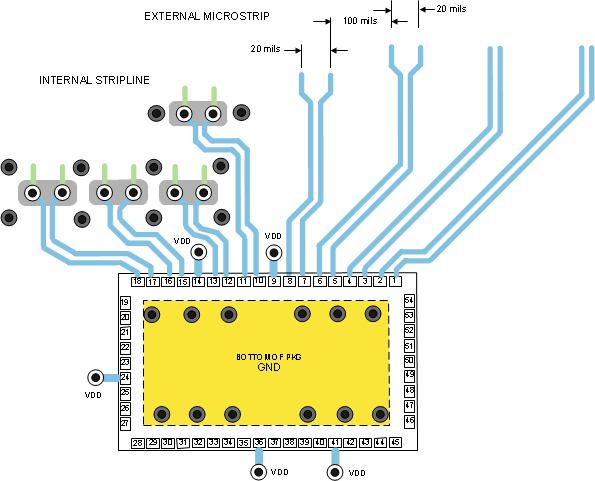ZHCSEN5C October 2012 – December 2015 DS125MB203
PRODUCTION DATA.
- 1 特性
- 2 应用
- 3 说明
- 4 修订历史记录
- 5 说明 (续)
- 6 Pin Configuration and Functions
- 7 Specifications
- 8 Detailed Description
- 9 Application and Implementation
- 10Power Supply Recommendations
- 11Layout
- 12器件和文档支持
- 13机械、封装和可订购信息
11 Layout
11.1 Layout Guidelines
The differential inputs and outputs are designed with 100-Ω differential terminations. Therefore, they should be connected to interconnects with controlled differential impedance of approximately 85-110 Ω. It is preferable to route differential lines primarily on one layer of the board, particularly for the input traces. The use of vias should be avoided if possible. If vias must be used, they should be used sparingly and must be placed symmetrically for each side of a given differential pair. Whenever differential vias are used, the layout must also provide for a low inductance path for the return currents as well. Route the differential signals away from other signals and noise sources on the printed-circuit-board. To minimize the effects of crosstalk, a 5:1 ratio or greater should be maintained between inter-pair spacing and trace width. See AN-1187 Leadless Leadframe Package (LLP) Application Report (SNOA401) for additional information on QFN (WQFN) packages.
The DS125MB203 pinout promotes easy high-speed routing and layout. To optimize DS125MB203 performance refer to the following guidelines:
- Place local VIN and VDD capacitors as close as possible to the device supply pins. Often the best location is directly under the DS125MB203 pins to reduce the inductance path to the capacitor. In addition, bypass capacitors may share a via with the DAP GND to minimize ground loop inductance.
- Differential pairs going into or out of the DS125MB203 should have adequate pair-to-pair spacing to minimize crosstalk.
- Use return current via connections to link reference planes locally. This ensures a low inductance return current path when the differential signal changes layers.
- Optimize the via structure to minimize trace impedance mismatch.
- Place GND vias around the DAP perimeter to ensure optimal electrical and thermal performance.
- Use small body size AC-coupling capacitors when possible — 0402 or smaller size is preferred. The AC-coupling capacitors should be placed closer to the Rx on the channel.
Figure 16 depicts different transmission line topologies which can be used in various combinations to achieve the optimal system performance. Impedance discontinuities at the differential via can be minimized or eliminated by increasing the swell around each hole and providing for a low inductance return current path. When the via structure is associated with thick backplane PCB, further optimization such as back drilling is often used to reduce the detrimental high-frequency effects of stubs on the signal path.
11.2 Layout Example
 Figure 16. Typical Routing Options
Figure 16. Typical Routing Options